
The quest for the world’s fastest aircraft has long been a challenge for aeronautical engineers and enthusiasts alike. These are the fastest fighter jets. From the Wright brothers’ first flight in 1903 to today’s supersonic jets, humans have always strived to push the boundaries of speed and innovation.
The quest for the world’s fastest aircraft
Historically, achieving greater speed was mainly a question of engine power. As aircraft became larger and more complex, the development of jet engines revolutionized aviation, allowing aircraft to fly faster and more efficiently. In the 1950s, the race for the fastest aircraft began in earnest with the introduction of experimental aircraft such as the Bell X-1 and the North American X-15.
In 1969, the Boeing 747 was introduced, revolutionizing commercial aviation and setting new speed records. However, it wasn’t until the introduction of the Concorde in 1976 that commercial aviation truly broke the sound barrier, reaching speeds of up to Mach 2.04, or over 1,500 mph.
Despite its success, the Concorde was retired from service in 2003 due to safety and fuel consumption concerns. However, the quest for speed did not end there. Today, companies such as SpaceX are developing reusable rockets capable of traveling at speeds close to Mach 25, paving the way for commercial space travel in the future.
However, the quest for the fastest aircraft is not just about breaking speed records. It is also about advancing technology and innovation in aviation to make air travel safer and more efficient. From reducing carbon emissions to developing quieter and more comfortable aircraft, the pursuit of speed has paved the way for countless innovations in aviation.
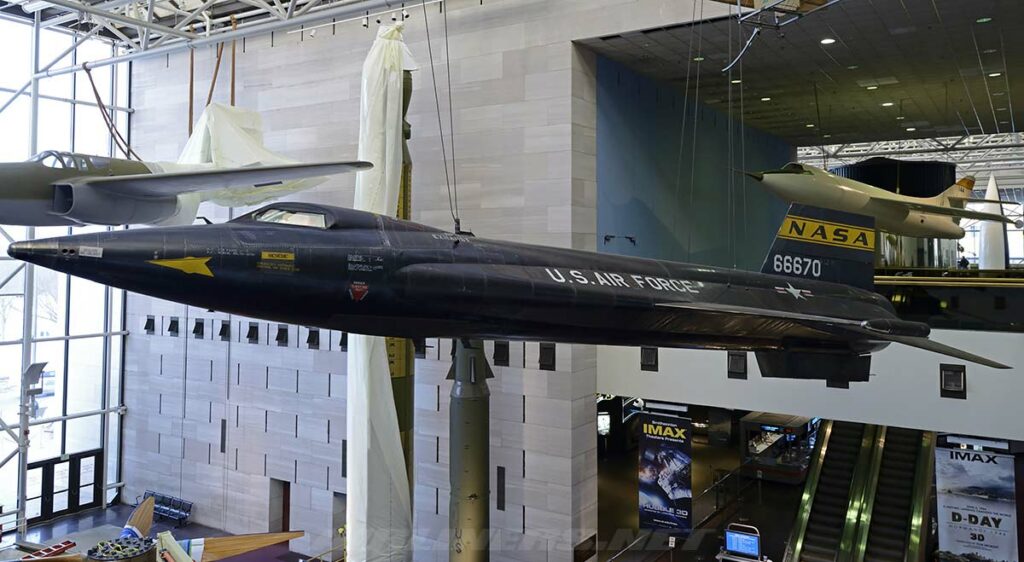
Why is speed important for aircraft?
Speed is essential for aircraft for several reasons. First, increased speed reduces travel time, making the transport of goods and people more efficient. Faster aircraft can cover greater distances in less time, improving global connectivity and accessibility. This is particularly important in emergency situations, where the rapid transport of medical supplies or disaster response teams can save lives.
In addition, speed is directly linked to operational efficiency and profitability. Faster aircraft can operate more flights in a given time frame, resulting in increased productivity and revenue for airlines. Furthermore, faster aircraft can optimize fuel consumption by spending less time in the air, thereby reducing operating costs and environmental impact.
From a military perspective, speed plays a critical role in reconnaissance, interception, and engagement. Faster aircraft can quickly reach the battlefield, respond to threats, and provide air support, giving a tactical advantage in combat scenarios.
The desire to increase speed stems from humanity’s innate curiosity, ambition, and desire for progress. Throughout history, humans have sought to push the boundaries of what is possible, overcome obstacles, and achieve feats once considered impossible. The pursuit of greater speed reflects our desire to overcome challenges, explore new frontiers, and advance technological capabilities. Faster aircraft not only showcase technological prowess, but also inspire a sense of national pride, symbolizing a country’s aeronautical achievements and military power.
The fastest aircraft are military aircraft
The fastest aircraft are generally military aircraft, mainly because they are designed to meet specific operational requirements. Military aircraft, particularly fighter jets, are built to reach high speeds in order to fulfill their crucial roles in air combat, reconnaissance, interception, and rapid response. Speed is a vital attribute for military aircraft for several reasons. First, speed capabilities allow fighter jets to quickly reach their designated area of operation, intercept hostile aircraft, and engage in air combat effectively. Speed provides an advantage in terms of maneuverability, evasion, and the ability to quickly engage or disengage from a target.
In addition, military aircraft often require high speeds to carry out reconnaissance missions. Rapid overflights of a target area allow essential intelligence and surveillance data to be gathered in a shorter time frame, improving situational awareness and operational effectiveness.
Furthermore, the ability to rapidly deploy forces and provide air support is crucial in military operations. Fast transport aircraft, such as strategic bombers or cargo planes, can quickly move troops, supplies, and equipment to remote locations, enabling rapid response and improving the readiness of armed forces.
While military aircraft prioritize speed, commercial aircraft are designed differently. Airliners focus on factors such as fuel efficiency, passenger comfort, and long-range capabilities rather than pure speed. Commercial aviation emphasizes transportation safety and reliability, operational efficiency, and profitability, which do not necessarily require the extreme speeds of military aircraft.
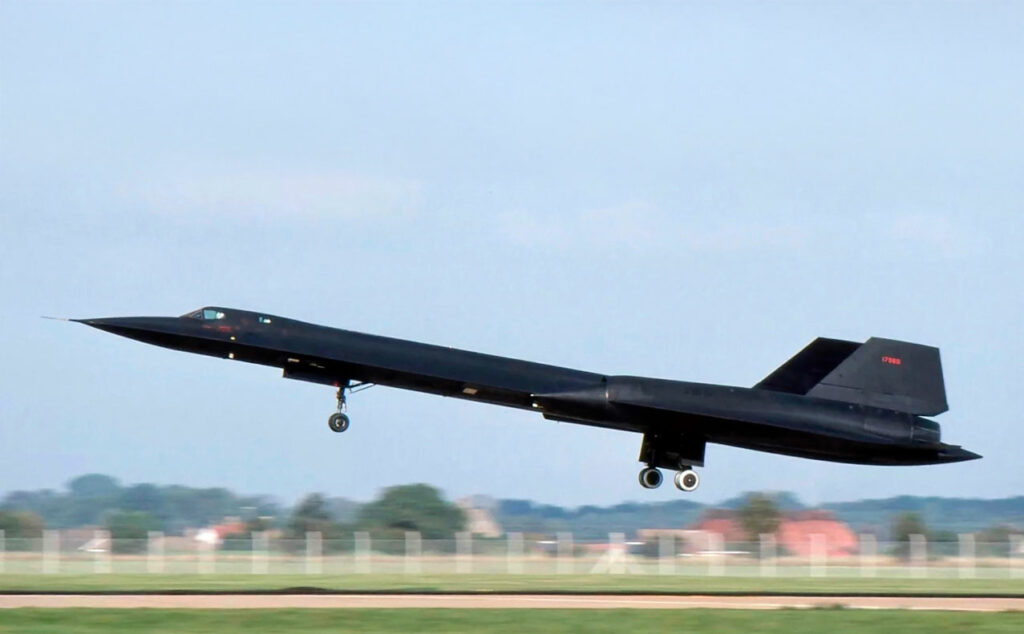
The fastest aircraft in the world today
North American X-15 – Mach 6.7
The North American X-15 holds an undisputed place among the world’s fastest aircraft, with an incredible top speed of Mach 6.7 (approximately 4,520 mph or 7,273 km/h).. This cutting-edge aircraft, operated by NASA and the US Air Force in the 1960s, pushed the boundaries of aviation and human endurance. The X-15’s exceptional speed is due to its revolutionary design and propulsion system. Equipped with a powerful XLR99 rocket engine, the X-15 is powered by a combination of liquid oxygen and anhydrous ammonia, enabling it to reach extraordinary speeds. In addition, its slender fuselage, advanced aerodynamics, and use of unconventional materials such as titanium and Inconel helped reduce drag and improve performance. The North American X-15 remains an iconic symbol of technological achievement and a testament to humanity’s relentless pursuit of pushing the boundaries of flight.
Lockheed SR-71 Blackbird – Mach 3.3
The Lockheed SR-71 Blackbird, a marvel of aeronautical engineering, is proud to be one of the fastest aircraft in the world, with a breathtaking top speed of Mach 3.3 (approximately 3,529 km/h or 2,193 mph). Renowned for its unmatched speed and stealth capabilities, the Blackbird’s blazing speed is primarily attributed to its unique design features and cutting-edge technologies. The aircraft’s distinctive shape, with its long, slender fuselage and aerodynamic profile, minimized drag during cruise at extreme speeds. In addition, the Blackbird’s two Pratt & Whitney J58 turbojet engines, supplemented by afterburners, produced immense thrust and enabled it to travel at remarkable speeds. To withstand the enormous heat generated by high-speed flight, the aircraft was equipped with a revolutionary titanium frame capable of withstanding extreme temperatures. The Lockheed SR-71 Blackbird remains an iconic symbol of technological prowess and a testament to humanity’s desire to push the boundaries of aviation.
Mikoyan-Gurevich MiG-25 Foxbat – Mach 3.4
The Mikoyan-Gurevich MiG-25 Foxbat, a legendary Soviet aircraft, is a testament to speed and strength, with a remarkable top speed of Mach 3.2 (approximately 3,435 km/h). The Foxbat’s exceptional speed can be attributed to a combination of advanced design and powerful engines. The aircraft’s sturdy airframe, constructed from a mixture of steel and titanium, enabled it to withstand the immense forces encountered during supersonic flight. Its powerful Tumansky R-15 turbojet engines, known for their afterburner capability, provided the Foxbat with exceptional thrust, propelling it to incredible speeds. In addition, the MiG-25 incorporates various design elements, such as swept wings and an aerodynamic fuselage, to reduce drag and optimize its aerodynamic performance. Thanks to its remarkable speed and impressive capabilities, Mikoyan-Gurevich’s MiG-25 Foxbat firmly established itself as one of the fastest aircraft of its time, highlighting the Soviet Union’s prowess in the field of aviation technology.
Bell X-2 Starbuster – Mach 3.19
The Bell X-2 Starbuster, a pioneer in supersonic flight, reached a staggering top speed of Mach 3.19 (approximately 3,368 km/h). Developed in the 1950s, this revolutionary aircraft contributed significantly to our understanding of high-speed flight. The X-2’s impressive speed can be attributed to its innovative design and advanced propulsion system. Equipped with a powerful XLR25 rocket engine, the X-2 was capable of generating immense thrust and propelling itself to remarkable speeds. The aircraft’s sleek, streamlined shape, combined with its swept-back wings and pointed nose, helped reduce drag and improve the aircraft’s aerodynamic performance. In addition, the X-2 was constructed using advanced materials such as stainless steel and Inconel, enabling it to withstand the intense heat generated during high-speed flights. The remarkable speed of the Bell X-2 Starbuster and its contribution to the advancement of supersonic technology make it an iconic symbol of aeronautical achievement.
XB-70 Valkyrie (United States) – Mach 3.0
The XB-70 Valkyrie, an extraordinary feat of American engineering, reached an impressive maximum speed of Mach 3.0 (approximately 3,219 km/h). This revolutionary supersonic bomber, developed in the 1960s, pushed the boundaries of aeronautical innovation. The Valkyrie’s impressive speed can be attributed to a combination of advanced design principles and powerful engines. The aircraft features a delta wing with adjustable outer panels, allowing for optimized performance at different speeds. Its six General Electric J93 turbojet engines, supplemented by afterburners, provided exceptional thrust, propelling the XB-70 to astonishing speeds. In addition, the XB-70 featured a unique honeycomb construction using stainless steel and titanium, which made it extremely strong while keeping its weight to a minimum. Although the XB-70 Valkyrie project was ultimately canceled, the aircraft’s impressive speed and advanced technologies contributed to significant advances in supersonic flight research and development. The XB-70 Valkyrie stands as a testament to the United States’ commitment to pushing the boundaries of aviation technology.
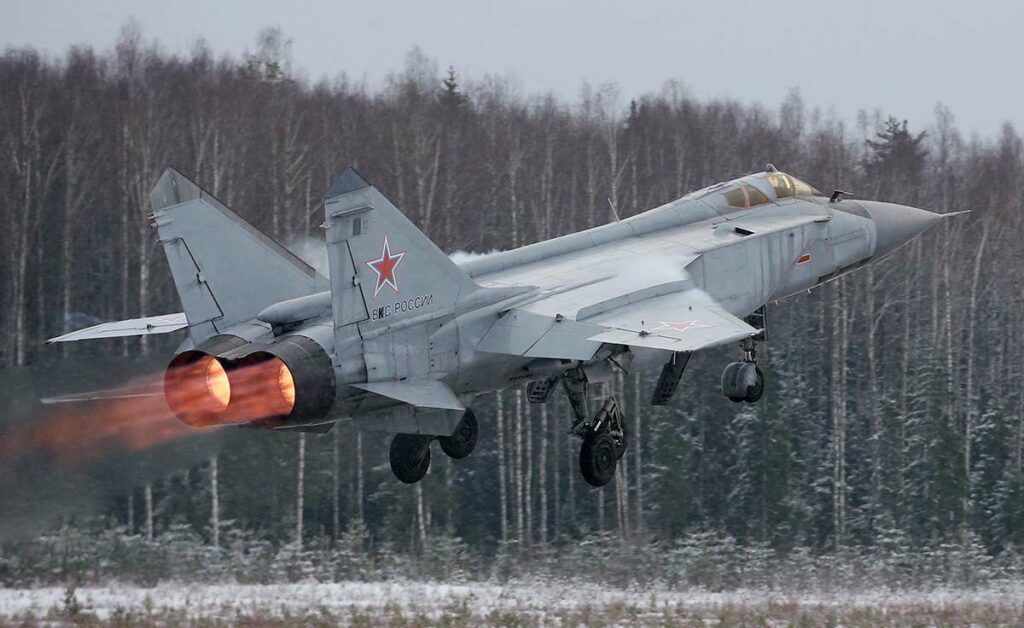
Mikoyan MiG-31 Foxhound – Mach 2.83
The Mikoyan MiG-31 Foxhound, an exceptional Russian interceptor aircraft, reaches an impressive maximum speed of Mach 2.83 (approximately 1,860 mph or 2,993 km/h). The Foxhound’s exceptional speed can be attributed to a combination of advanced design features and powerful engines. Its distinctive aerodynamic shape, with its long, slender fuselage, combined with variable-geometry wings, minimizes drag and optimizes high-speed performance. The aircraft is equipped with two powerful D30-F6 turbojet engines, specially designed for high-altitude and high-speed flight. These engines, capable of producing immense thrust, propel the MiG-31 to incredible speeds. The aircraft’s robust construction, including its strong airframe and advanced avionics, allows it to withstand the stresses encountered during high-speed operations. The Mikoyan MiG-31 Foxhound is a testament to Russian engineering prowess, displaying remarkable speed and formidable capabilities in supersonic flight.
McDonnell Douglas F-15 Eagle – Mach 2.5
The McDonnell Douglas F-15 Eagle, an iconic American fighter jet, reaches an impressive top speed of Mach 2.5 (approximately 1,650 mph or 2,655 km/h). The F-15’s exceptional speed is the result of a combination of advanced design principles and powerful engines. The aircraft’s sleek, aerodynamic shape, characterized by a slender fuselage, swept wings, and carefully designed contours, minimizes drag and improves high-speed performance. The F-15 is equipped with two Pratt & Whitney F100 turbofan engines, renowned for their thrust capabilities. These engines, combined with the aircraft’s lightweight yet robust construction, enable the F-15 to accelerate to remarkable speeds. In addition, the F-15 incorporates advanced avionics and radar systems, which contribute to its exceptional situational awareness and combat capabilities. With its impressive speed and formidable capabilities, the McDonnell Douglas F-15 Eagle remains a symbol of American air superiority and technological innovation.
Lockheed YF-12A Blackbird – Mach 2.5
The Lockheed YF-12A Blackbird, a revolutionary reconnaissance aircraft, reaches an impressive top speed of Mach 2.5 (approximately 2,655 km/h). The YF-12A’s exceptional speed is due to its advanced design and powerful engines. Derived from the iconic SR-71 Blackbird, the YF-12A features a sleek fuselage and carefully profiled surfaces to minimize drag and optimize high-speed performance. Two Pratt & Whitney J58 turbojet engines, equipped with afterburners, provide exceptional thrust and propel the YF-12A to remarkable speeds. In addition, the YF-12A is equipped with advanced avionics and radar systems, enabling it to conduct high-speed reconnaissance missions with unprecedented accuracy and efficiency. Although the YF-12A program was ultimately canceled, its impressive speed and technological advances paved the way for future aerospace innovations. The Lockheed YF-12A Blackbird remains a testament to Lockheed’s engineering prowess and contributions to supersonic flight capabilities.
Convair B-58 Hustler – Mach 2
The Convair B-58 Hustler, a revolutionary strategic bomber for the US Air Force, reached an impressive maximum speed of Mach 2 (approximately 1,325 mph or 2,132 km/h).. The B-58’s remarkable speed can be attributed to its innovative design and powerful engines. With its thin, slender delta wing configuration, the Hustler minimizes drag and maximizes aerodynamic efficiency during supersonic flight. The four General Electric J79 turbojet engines, equipped with afterburners, provided exceptional thrust, enabling the B-58 to reach impressive speeds. In addition, the B-58 incorporated advanced materials such as honeycomb structures and titanium alloys, allowing it to withstand the high temperatures generated by high speeds. The Convair B-58 Hustler’s exceptional speed and technological advances played a crucial role in the development of supersonic strategic bombers, highlighting its importance in military aviation history.
Sukhoi Su-27 Flanker – Mach 2.35
The Sukhoi Su-27 Flanker, an exceptional Russian air superiority fighter, reaches an impressive maximum speed of Mach 2.35 (approximately 2,495 km/h). The Su-27’s remarkable speed is the result of its advanced design and powerful engines. The aircraft’s sleek, aerodynamic shape, with its streamlined fuselage, swept-back wings, and canards, reduces drag and improves high-speed performance. The Su-27 is equipped with two Saturn AL-31 turbofan engines, known for their thrust capabilities and maneuverability. These engines, combined with the aircraft’s lightweight but robust construction, enable the Su-27 to reach impressive speeds. In addition, the Su-27 is equipped with advanced avionics and fly-by-wire flight control systems, contributing to its agility and exceptional combat capabilities. With its impressive speed and formidable capabilities, the Sukhoi Su-27 Flanker remains a symbol of Russian engineering prowess and air superiority.
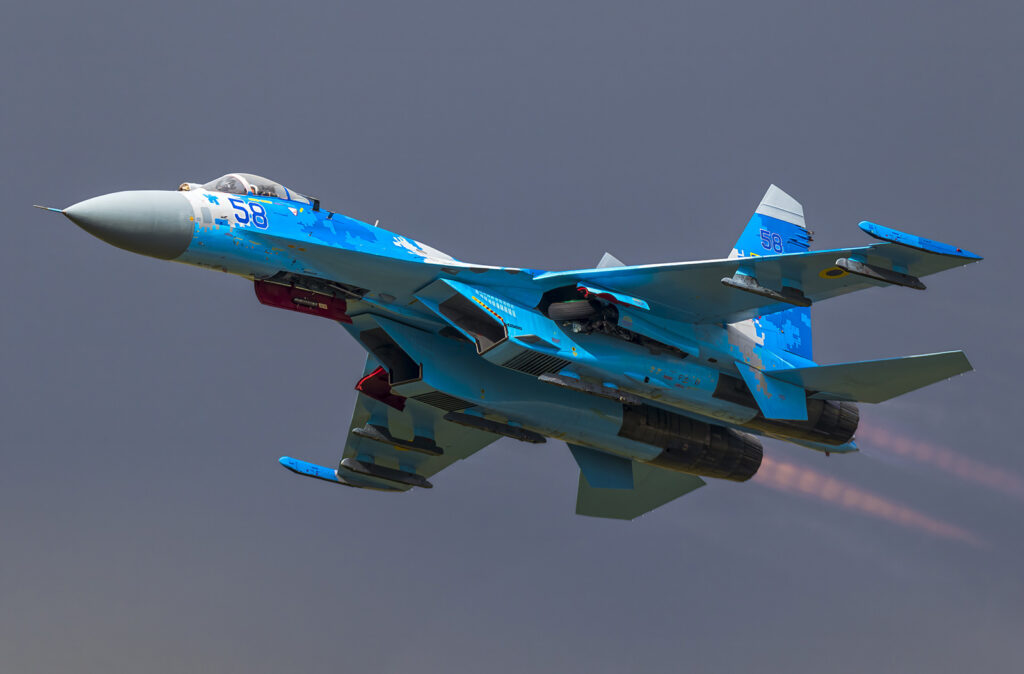
F-14 Tomcat (United States) – Mach 2.34
The F-14 Tomcat, an iconic American supersonic fighter jet, reaches an impressive top speed of Mach 2.34 (approximately 1,544 mph or 2,485 km/h). The F-14’s exceptional speed can be attributed to its advanced design and powerful engines. Thanks to its unique swing-wing configuration, the Tomcat could adjust the angle of its wings to optimize performance at different speeds. This capability allows the aircraft to minimize drag and improve maneuverability in supersonic flight. The F-14 is equipped with two General Electric F110 turbofan engines, renowned for their thrust capabilities. These engines, combined with the Tomcat’s robust airframe and advanced avionics, enable the aircraft to reach remarkable speeds. In addition, the F-14 incorporates sophisticated radar and weapons systems, making it a formidable air superiority fighter. With its impressive speed and versatile capabilities, the F-14 Tomcat symbolizes the prowess of American engineering and remains an enduring icon in military aviation history.
General Dynamics F-111 Aardvark – Mach 2.5
The General Dynamics F-111 Aardvark, a versatile American supersonic attack aircraft, reached an impressive maximum speed of Mach 2.5 (approximately 2,655 km/h). The remarkable speed of the F-111 can be attributed to its advanced design and powerful engines. Thanks to its sleek, aerodynamic shape with a variable-geometry wing configuration, the Aardvark could adjust the angle of its wings to achieve optimal performance at different speeds and according to mission requirements. This capability allowed the aircraft to minimize drag and maximize aerodynamic efficiency during high-speed flights. The F-111 was equipped with two Pratt & Whitney TF30 turbofan engines, known for their thrust capabilities. These engines, combined with the aircraft’s lightweight but robust construction, enabled the F-111 to reach impressive speeds. In addition, the F-111 is equipped with advanced avionics, terrain-following radar, and a sophisticated weapons system, enabling it to undertake precision strike missions. With its remarkable speed and versatile capabilities, the General Dynamics F-111 Aardvark represented a significant advance in supersonic attack aircraft technology.
F-22 Raptor (United States) – Mach 2.25
The F-22 Raptor, a fifth-generation American stealth fighter jet, reaches an impressive top speed of Mach 2.25 (approximately 2,414 km/h). The Raptor’s exceptional speed is the result of its advanced design, aerodynamics, and powerful engines. With its sleek, angular shape, carefully crafted contours, and stealth features, the F-22 minimizes drag and maximizes overall performance at high speeds. The aircraft is equipped with two Pratt & Whitney F119-PW-100 turbofan engines, specially designed for high thrust-to-weight ratios and supersonic operations. These engines, combined with the Raptor’s lightweight yet robust construction, enable the aircraft to achieve remarkable speeds. In addition, the F-22 incorporates advanced avionics, sensor fusion technology, and stealth capabilities, making it a formidable air superiority platform. With its impressive speed, unmatched maneuverability, and advanced features, the F-22 Raptor represents the pinnacle of modern fighter aircraft technology and is a testament to American engineering excellence.
Mikoyan MiG-29 Fulcrum – Mach 2
The Mikoyan MiG-29 Fulcrum, a versatile Soviet/Russian fighter aircraft, reaches an impressive maximum speed of Mach 2 (approximately 1,320 mph or 2,122 km/h). The Fulcrum’s remarkable speed is the result of its aerodynamic design and powerful engines. The aircraft features a sleek, aerodynamic fuselage and swept-back wings, which help reduce drag and improve high-speed performance. The MiG-29 is equipped with two Klimov RD-33 turbofan engines, renowned for their thrust capabilities. These engines, combined with the aircraft’s lightweight construction, enable the Fulcrum to reach impressive speeds. In addition, the MiG-29 is equipped with advanced avionics, radar systems, and a wide range of weapons, making it a highly capable air superiority fighter. With its remarkable speed and agility, the Mikoyan MiG-29 Fulcrum represents a significant contribution to Soviet and Russian aviation and remains an important asset in modern combat operations.
Chengdu J-10 – Mach 2
The Chengdu J-10, a modern Chinese multirole fighter, reaches an impressive maximum speed of Mach 2 (approximately 1,320 mph or 2,122 km/h). The J-10’s remarkable speed is the result of its aerodynamic design and powerful engines. The aircraft features a sleek, aerodynamic airframe with carefully profiled surfaces, which minimizes drag and optimizes high-speed performance. The J-10 is equipped with a powerful turbojet engine with afterburner, giving it significant thrust capabilities. This engine, combined with the aircraft’s lightweight construction and advanced avionics systems, enables the J-10 to reach impressive speeds. In addition, the J-10 incorporates advanced fly-by-wire flight controls, giving it enhanced maneuverability and agility. With its remarkable speed and versatile capabilities, the Chengdu J-10 represents a significant advance in Chinese military aviation technology and is a crucial asset for a variety of combat roles.
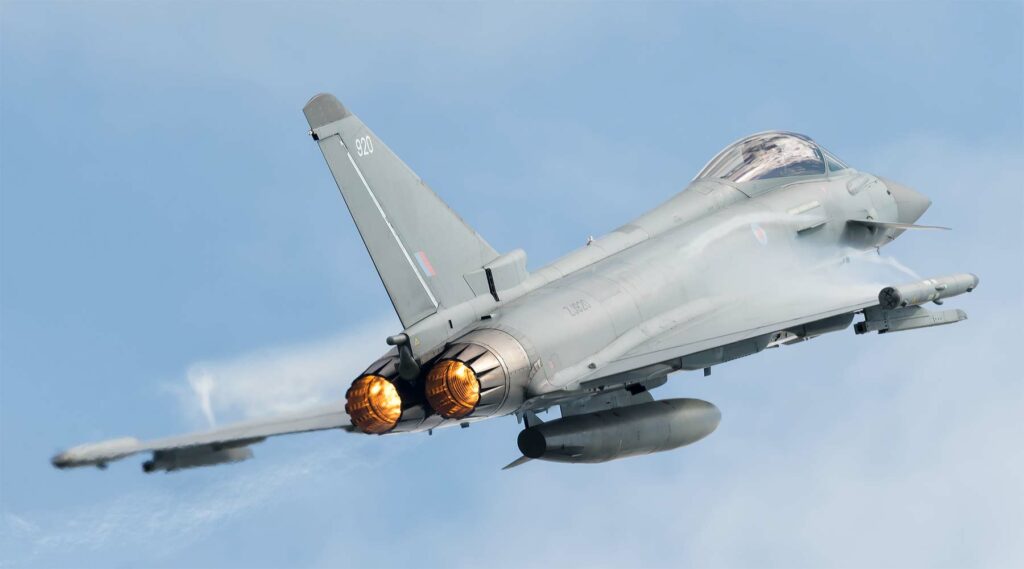
Eurofighter Typhoon – Mach 2
The Eurofighter Typhoon, a highly advanced European multirole combat aircraft, reaches an impressive maximum speed of Mach 2 (approximately 1,320 mph or 2,122 km/h). The Typhoon’s remarkable speed is the result of its advanced aerodynamic design and powerful engines. The aircraft’s sleek, streamlined shape, with its delta wings and canards, reduces drag and optimizes high-speed performance. The Typhoon is equipped with two Eurojet EJ200 afterburning turbofan engines, known for their thrust capabilities. These engines, combined with the aircraft’s lightweight construction and advanced avionics, enable the Typhoon to reach impressive speeds. In addition, the Typhoon incorporates advanced radar systems, sensor fusion technology, and sophisticated weapon systems, making it a formidable platform for air superiority and ground attack. With its speed, maneuverability, and advanced features, the Eurofighter Typhoon represents a significant collaboration in European military aviation and is a symbol of technological excellence.
Saab JAS 39 Gripen (Sweden) – Mach 2.0
The Saab JAS 39 Gripen, a Swedish multirole fighter aircraft, reaches a maximum speed of Mach 2.0 (approximately 1,320 mph or 2,122 km/h). The Gripen’s remarkable speed is the result of advanced design and a powerful engine. The aircraft’s sleek, aerodynamic configuration, with its delta wings and canard, reduces drag and optimizes high-speed performance. The Gripen is equipped with a single Volvo RM12 afterburning turbofan engine, which gives it considerable thrust capabilities. This engine, combined with the Gripen’s lightweight construction, enables the aircraft to reach impressive speeds. In addition, the Gripen incorporates advanced avionics systems, including modern radars, sensors, and communication technologies, which enhance its situational awareness and combat effectiveness. With its remarkable speed, agility, and advanced features, the Saab JAS 39 Gripen represents Swedish engineering excellence and remains a highly capable and versatile fighter aircraft on the international market.
Dassault Rafale – Mach 1.8
The Dassault Rafale, a formidable French multirole fighter aircraft, reaches a maximum speed of Mach 1.8 (approximately 1,190 mph or 1,915 km/h). The Rafale’s impressive speed is the result of its advanced design and powerful engines. The aircraft’s sleek, aerodynamic shape, with its delta wings and canards, minimizes drag and optimizes high-speed performance. The Rafale is equipped with two Snecma M88 afterburning turbofan engines, renowned for their thrust capabilities. These engines, combined with the Rafale’s lightweight construction, enable the aircraft to reach remarkable speeds. In addition, the Rafale incorporates advanced avionics systems, including radars, sensors, and advanced electronic warfare capabilities, which enhance its combat effectiveness in air-to-air and air-to-ground missions. With its impressive speed, agility, and advanced features, the Dassault Rafale represents the excellence of French engineering and is an essential asset in modern air operations.
War Wings Daily is an independant magazine.